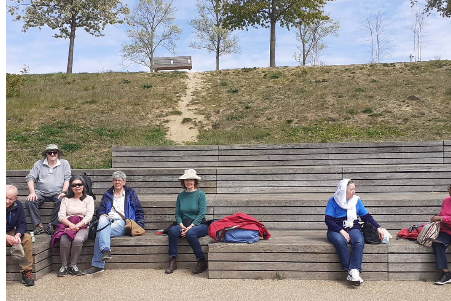
This project runs a series of wildlife themed walks during autumn, winter and spring when people can be less active due to shorter daylight hours and unpredictable weather. The project delivers between 10-15 walks and targets those that are socially isolated and classed as vulnerable. This target audience can be expanded to include a wider range of participants.
The walks can be a mixture of local walks and walks in different areas of London. The chosen locations would ideally offer a diversity of habitat and wildlife to help to ensure a positive and engaging experience. Locations such as The Wetlands Centre, Kew Gardens, Hampstead Heath, along the Thames or Richmond Park provide ideal walking routes with plenty of stimulus.
Participants can put forward their own ideas to increase engagement or can vote for which one to visit each time.
Entry fees to some wildlife attractions can be covered by the project, offering the opportunity to experience green spaces that may have previously been too expensive for some participants.
The walks can be run as an enjoyable social event, where groups meet at a central location or travel together as a group, as well as creating the opportunity to walk and have lunch together at the destination. This approach allows for the most vulnerable and socially isolated to gain confidence and develop meaningful connections with their peers within their local community.
Target audience and engagement
- The key target audience for this project is those who are socially isolated and are classed as vulnerable or extremely vulnerable
- The target group could be easily adapted to support those with physical and non-physical health problems, disabilities, over-60s or disadvantaged individuals or families
- Promote your project by hosting or attending events and using publicity materials, such as leaflets or posters
- Use existing networks of community groups, or seek out specialist and charity organisations who work with your target group, to raise awareness of your activities
- Engagement can also be through social media, with specific targeting to potential user groups
- Word of mouth is also especially effective for the older groups
Reach
- Medium (55 - 75 participants)
- Geographically - anywhere there are green, open spaces, footpaths and walkways with plenty of wildlife to observe. Example spaces include, parks and woodlands, river and canal paths, estates and managed gardens. These could be local or anywhere across London
Equipment needed
- Walk resources, including maps, work sheets and activity packs (if needed)
- Hi-Vis vests
Resources needed
- Project Leader:
-Oversee the project, ensure the participants feel safe and are enjoy their experience
-Track equipment and make sure it is returned
-Ensure all funding criteria and documentation is met
-Run risk assessments for safeguarding, injuries and identify any other concerns which may affect project delivery
-Gather feedback from participants
-The project lead should have the requisite level of DBS, understand health and safety needs and preferably be first aid trained (DBS checks can be funded through the grant) - Volunteers/Project Officers:
-Help answer queries
-Contribute to overseeing activities and potentially fix any equipment or other issues
-Run the scheduled walks - Storage Space:
-You will need somewhere to store equipment. This could be at a community centre, in an existing office, or perhaps another local business that has a storage facility - Publicity:
-Flyers and posters for publicity of the sessions - Refreshments:
-Tea, coffee and snacks at sessions - this will lighten the mood and offers an incentive for people to come. You can also stop off for refreshments at a café along the walking route, in the wildlife centre, or bring your own as part of a picnic event built into the walk plan
Estimated project costs
- Staff administrative costs £150 - £300
- Staff costs for leading walks £1,500
- Entrance fees £300
- Promotional leaflets/flyers £50
- Lunch costs £300
- Travel costs £240
- Public liability insurance (if needed) £170
Top tips/key learnings
- Try to build a flexible programme which includes morning, afternoon and weekend walks to allow participants the flexibility around their daily lives
Planning and advertising the whole calendar of events early allows the participants to build the walks into their schedule - Due to the unpredictable weather conditions during autumn to spring, activities will need to be planned flexibly with alternatives in place for poor weather
- Get feedback from attendees to see where they would like to go for future walks
- Be clear and upfront about the amount of walking involved even for shorter distances. This approach ensures that participants who sign up for the walk are physically able to walk the required distance. You could even split participants into different distance groups if needed
- Be patient with participant numbers if recruitment is slow initially. Numbers will increase once positive word-of-mouth develops
- Take advantage of the training programme that is offered by Walking and Cycling Grants London
Maximising local contacts
- Try to make contact and build working relationships with charities/organisations that specialise in your chosen target audience. This will allow for referrals to be made to you and increase your overall participant reach
- Engage with your local council - they may be able to lend you equipment, help market the project, or help secure a local space for meetings
This project idea was provided by Hammersmith Community Gardens Association - Twitter - Instagram
If you decide to run your own version of this project in your community, please email us at wcgl@groundwork.org.uk. We love to hear that we are inspiring people to walk and cycle.